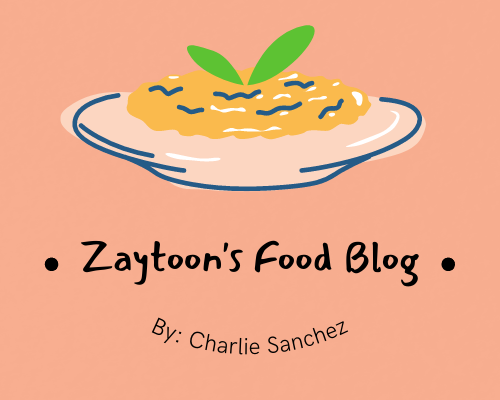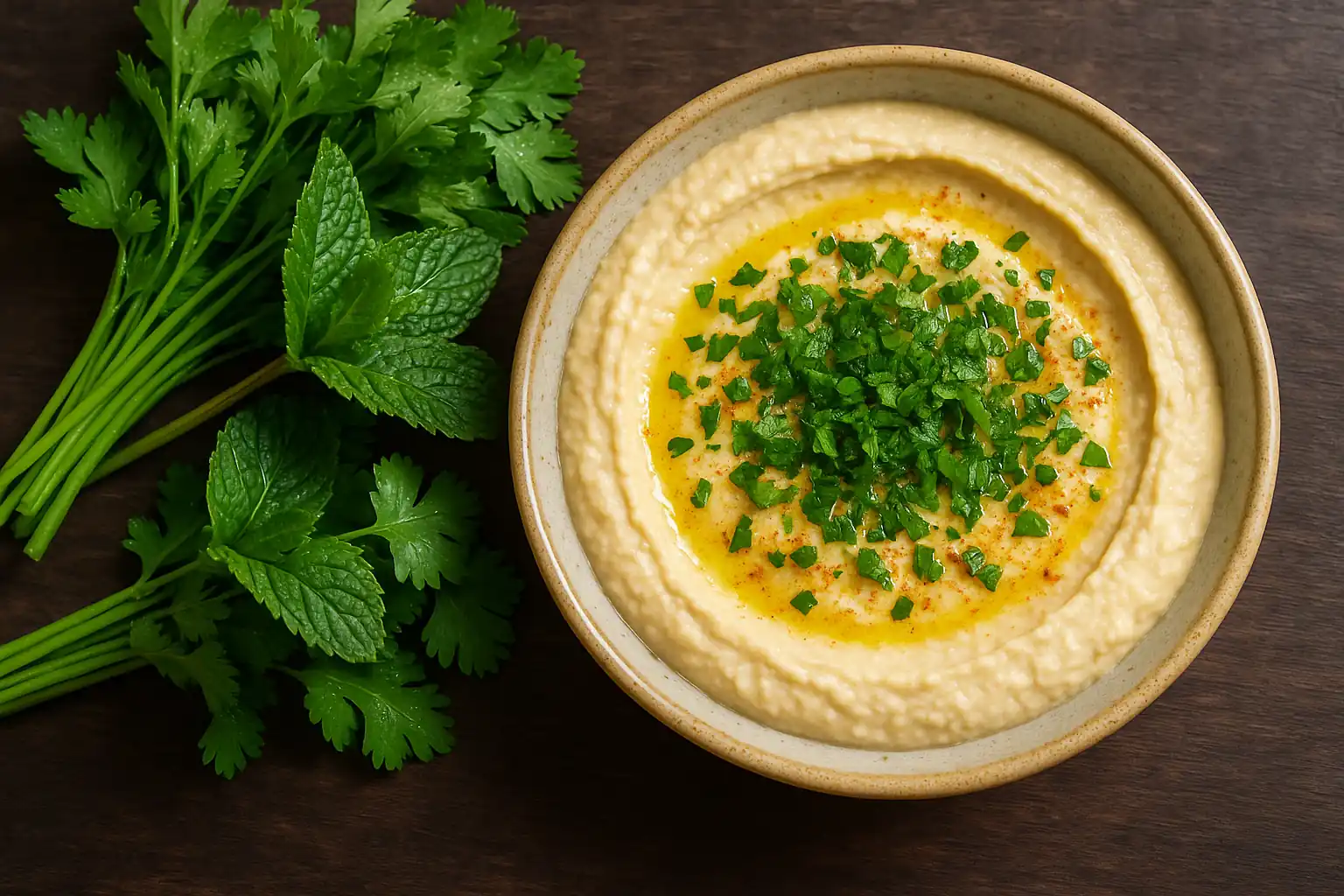Imagine tabbouleh without parsley or hummus served plain, missing that burst of fresh green on top. They just feel incomplete, right? Yet, many home cooks regularly skip fresh herbs or don’t use them correctly.
In Middle Eastern cooking, herbs like parsley, mint, and cilantro bring balance, brightness, and depth. In this article, we’ll cover the traditional roots and distinctive flavours of these herbs. We’ll also explore their health benefits, storage, preparation, and creative uses.
Ready to sharpen your herb game and bring your dishes to life? Let’s get into it.
The Origins of Middle Eastern Herb Traditions
Herbs have influenced Middle Eastern cooking for thousands of years. They embodied cultural significance, spiritual meaning, and hospitality, among other things. In other cuisines, herbs are usually treated as decorative touches.
We’ll now explore where these herbal traditions began and why they continue to hold meaning today.
Ancient Civilisations and Culinary Beginnings
Herbs feature in some of the earliest recorded recipes from Mesopotamia and Persia. Cuneiform tablets describe coriander, dill, and thyme being combined with grains or broth.
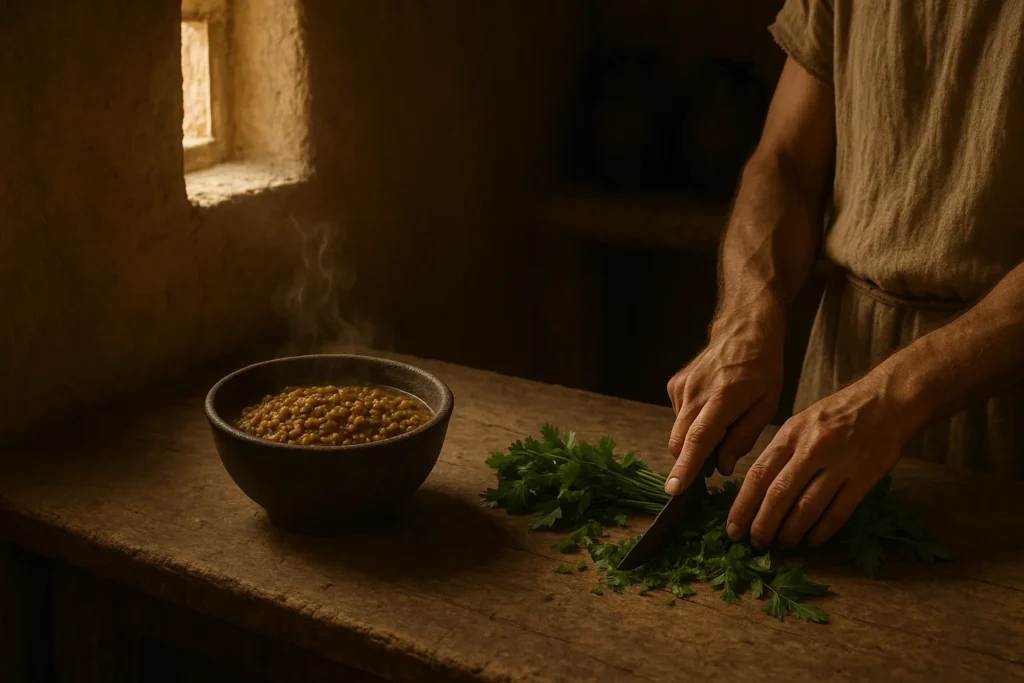
In Persian kitchens, aromatic greens were prized for their cooling and cleansing properties, especially in hot, dry conditions. On the other hand, the Levant saw parsley and mint added directly into bulgur dishes and lentil stews.
Even simple, everyday meals relied on herbs to brighten dense ingredients. With limited access to imported spices, these greens brought variety, aroma, and freshness straight from the earth (honestly, they made the difference between a bland meal and something truly memorable for me a number of times).
Spiritual Uses and Symbolism of Fresh Herbs
Herbs frequently appear in religious or ceremonial meals across the region. Mint is commonly brewed into tea and shared with guests as a mark of respect at weddings, funerals, or casual gatherings.
And in some Palestinian and Lebanese Christian homes, parsley holds symbolic weight during Holy Week, representing rebirth and seasonal renewal.
These small customs turn a meal into a gesture. The inclusion of herbs adds emotional and cultural depth. Families continue these traditions, passing them along through everyday cooking.
How Regional Preferences Defined Herb Choices
Different parts of the Middle East lean on different greens. In the Levant, parsley plays a central role in recipes like tabbouleh, fattoush, and grape leaves. You’ve probably seen these vibrant green salads at Mediterranean restaurants, where the herbs are sometimes the star of the dish.
Meanwhile, cilantro, or kuzbara, is more common in Iraqi and Iranian kitchens. It is usually cooked into stews like ghormeh sabzi or folded into egg dishes.
Coastal regions often favour tender, fresh herbs. But drier inland areas preserve their greens for storage, using dried thyme, oregano, or sage throughout the year.
These choices represent climate, history, and regional taste.
Middle Eastern Herbs as a Gesture of Respect
How herbs are handled in the kitchen says something about the cook. They’re typically washed thoroughly, chopped with care, and used while fresh. A meal with wilted or bruised herbs can feel rushed or inattentive.
Take mansaf, for example, a traditional Jordanian dish of lamb and rice. The final sprinkle of chopped parsley and toasted nuts indicates hospitality. The effort shows the guest is truly welcome and that the food was made with pride.
This deep respect for herbs also influences how flavours are chosen and balanced. We’ll take a closer look at those details in the following section.
Flavour Profiles: Parsley, Mint and Cilantro
Fresh herbs bring direction and definition to Middle Eastern dishes. Each one adds its own scent, flavour, and texture. It changes how the entire meal comes together.
When you understand what makes parsley, mint, and cilantro taste the way they do, it becomes easier to choose the right herb for each dish.
Taste and Texture of Popular Fresh Herbs
Every herb brings a unique flavour to the plate. Some sharpen the flavours around them, while others cool or soften rich ingredients.
Here’s a side-by-side comparison:
| Trait | Parsley | Mint | Cilantro |
| Flavour Notes | Earthy, slightly bitter | Cool, sweet, sharp | Citrusy, herbal, sharp |
| Common Description | Fresh, grassy, peppery | Refreshing, menthol | Zesty, pungent |
| Strength | Moderate | High | Strong |
| Aftertaste | Clean and slightly nutty | Lingering, bright | Soapy to some palates |
Mint and cilantro can easily dominate flavours if too much is used. But parsley can mix smoothly without overwhelming the actual dish.
Why Herb Aromas Affect Food Experience
Fresh herbs get their amazing flavours from volatile oils. Volatile oils are aromatic compounds that quickly release their scent when you chop or gently press the leaves. Think of them like Nature’s natural perfume.
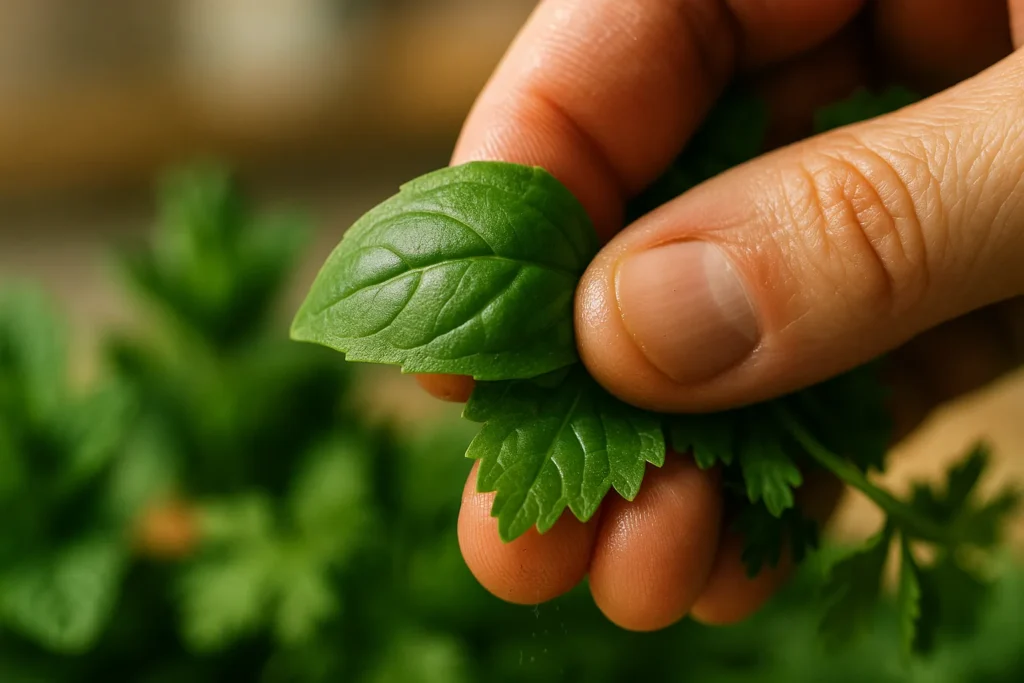
You smell the herb before you even taste it. And that initial scent influences your experience of the whole dish. Think about walking into a kitchen where someone’s just chopped fresh basil or mint. Your mouth starts watering before you’ve even seen the food.
So, how do specific herbs create their unique flavours?
Cilantro
Love it or hate it, cilantro’s got some serious chemistry going on. Those linalool and citronellol compounds create bright citrus and floral notes that can transform earthy or spicy foods in seconds.
For example, adding chopped cilantro to lentil soup just before serving adds a clean, almost lemony finish. This is common in dishes like shorbat adas or green rice with dill and herbs.
Mint
This herb attracts attention for its menthol content, which gives it a clean, cooling effect. It works well in dishes with garlic, chilli, or lemon.
Throw some mint into a cucumber salad or swirl it through yogurt dips like raita. Even better, fold it into rich meat dishes where it acts like a flavour controller, keeping garlic, chili, and lemon from overwhelming everything else.
Parsley
Parsley contains myristicin and apiol. These give it a mellow, slightly earthy tone that fits with nearly everything.
This herb plays a leading role in tabbouleh, where it balances lemon and bulgur. It also works as a finishing herb on grilled meats or roasted vegetables.
The real magic happens when you start thinking about these volatile oils as your flavour toolkit. Once you understand what each herb brings to the party, you can layer them with confidence instead of just hoping for the best.
Pro Tip: Rub a parsley leaf between your fingers, then do the same with mint. Their scents give a quick sense of how each one behaves with food. Smell is often the first clue to choosing the right match.
How Herbs Balance Fat, Spice and Acid
Middle Eastern food typically combines rich oils, sharp citrus, garlic, and warming spices. Herbs are used to soften or sharpen those edges, depending on what the dish needs.
- Parsley: It enriches dense or oily dishes like grilled lamb, hummus, or chickpea stew
- Mint: This herb helps to calm acidic or spicy flavours. It’s especially effective in sauces with yoghurt, lemon, or chilli.
- Cilantro: It provides an energetic, crisp finish to dishes like rice, lentils, or slow-cooked vegetables.
Each one also changes how the food feels in your mouth. Mint finishes with a cool tingle, while parsley adds freshness and a gentle bite. And cilantro gives a smooth, crisp pinch with a slightly zesty edge.
Best Herb Pairings for Middle Eastern Dishes
Use this flavour guide to match herbs with common Middle Eastern ingredients:
| Ingredient | Best Match Herb | Why It Works |
| Lamb | Parsley | Cuts richness with a clean, fresh edge |
| Lemon/Acid | Mint | Softens sharpness and cools the palate |
| Lentils | Cilantro | Adds contrast to an earthy base |
| Garlic | Mint | Reduces harshness and balances aroma |
| Rice | Cilantro | Brings citrus lift to heavier grains |
| Olive oil | Parsley | Lightens and freshens the overall flavour |
These pairings will help you create balanced dishes, so you don’t have to guess.
How to Keep Herbs Fresh and Flavourful
Fresh herbs bring brightness and depth to Middle Eastern dishes, but only when they’re truly vibrant. On the other hand, stale bunches dull flavour and upset the balance of a well-prepared plate. The difference between fresh and faded herbs can make or break your cooking. So, it’s important to know how to preserve them right.
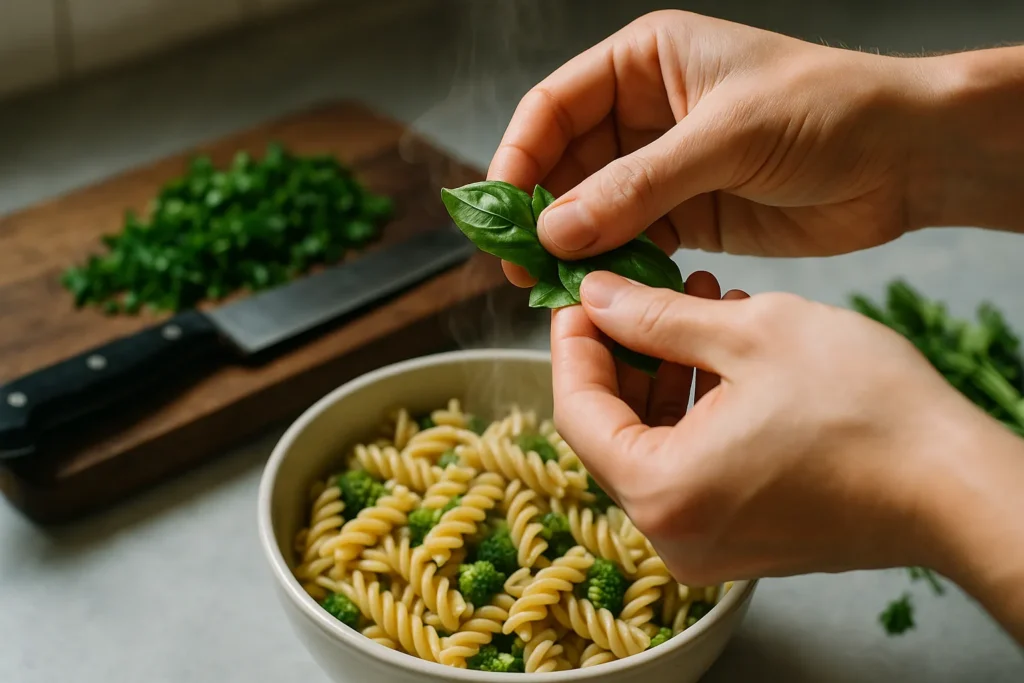
Good storage habits help keep every leaf crisp and aromatic. Here’s how to make the most of every herb you buy.
How to Choose Fresh Herbs at the Market
Fresh herbs deliver potent aromas and essential oils that improve your cooking. Knowing what to seek at the market provides a strong base for exceptional flavours.
Look for these signs when selecting your herbs:
- Colour and Texture: Leaves should be rich green, firm, and unbruised. Avoid anything with dry edges or discolouration.
- Aroma: Gently sniff the bunch. A bold, clean scent indicates freshness.
- Moisture: Watch out for condensation inside packaging. This indicates wilting or spoilage.
Storage Tricks to Prevent Herb Spoilage
Once your herbs are home, strategic storage can extend their life by days or sometimes even a week. The goal should be to keep them away from excess moisture and allow good airflow around the leaves.
Use one of these tried-and-tested methods:
- Glass Jar Method: Trim the stems and stand them upright in a glass of water (just like you would a bouquet). Loosely cover the top with a plastic bag.
- Paper Towel Wrap: Gently roll your unwashed herbs in a slightly damp paper towel. Then place them inside a sealed container or a resealable bag.
- Avoid Weight: Never stack anything on top of your herbs. Pressure will bruise the leaves and quicken decay.
Washing Tips to Avoid Soggy or Slimy Leaves
A quick rinse removes soil and grit, but too much water can easily ruin delicate leaves. The trick is to clean gently and dry thoroughly before storage or use.
Here’s how to wash them properly:
- Rinse Gently: Swish your herbs gently in cool water. This removes debris without bruising them.
- Dry Swiftly: Use a salad spinner or pat between towels to dry without damaging the leaves.
Best Ways to Chop and Use Herbs Without Losing Taste
Cutting technique directly impacts how the herb flavour reaches your plate. Remember that proper handling ensures maximum taste.
For better results during prep:
- Chop Last Minute: Wait until you’re ready to serve. Chopping too early dulls freshness rapidly.
- Don’t Waste Stems: Finely chop tender stems. This improves texture and maximises flavour in every bite.
- Tear Soft Leaves: Use your hands to tear delicate herbs like mint or basil. They can bruise under sharp metal blades.
How Freshness Affects Cooking With Fresh Herbs
Flavour strength fades rapidly once herbs are harvested. That sharp kick of parsley or cool burst of mint comes from oils that weaken each day.
Why this matters for your cooking:
- Oils at Work: Volatile oils carry aroma and taste. But these compounds break down quickly after picking or chopping.
- Sensory Impact: Think about how cilantro cuts through stews, mint calms rich sauces, and parsley sharpens salads and grains.
- Balanced Bites: Fresh herbs rejuvenate spice-heavy dishes. They uplift both warm and cold plates instantly.
Based on our experience, airflow is often overlooked when storing herbs. You’ve likely noticed how herbs go slimy when stuffed in plastic bags, right? Sealing them too tightly can trap gas and speed up spoilage. In contrast, a loosely covered container or perforated bag balances humidity with ventilation. This keeps herbs crisp and aromatic longer.
Health Benefits of Fresh Parsley, Mint and Cilantro
Beyond their incredible flavour impact, these fresh herbs also bring health benefits to your table. For centuries, Middle Eastern kitchens have used parsley, mint, and cilantro for both taste and wellness. Their roles in healing traditions and nutritional science make them more powerful than they seem on the plate.
Traditional Middle Eastern Herbal Remedies Explained
For generations, Middle Eastern households have used herbs for everyday remedies. These natural solutions remain trusted today. Let’s learn how each herb is applied in real-life settings.
Mint Tea for Nausea and Stomach Cramps
Fresh mint tea usually calms the digestive tract. Middle Eastern households commonly serve it after meals. People have used it to naturally ease bloating and headaches for centuries.
Parsley water as a Natural Diuretic
Traditionally, people soak parsley leaves in hot water. It helps reduce water retention. This practice is centuries old in Persian and Levantine medicine and was considered a gentle way to flush excess fluids.
Cilantro for Inflammation
Cilantro features in homemade tonics. These promote digestion and lower body heat, especially in Gulf traditions.
For instance, some Yemeni remedies combine cilantro with lime and honey to ease inflammation during hot seasons.
Scientific Reasons to Eat More Fresh Herbs
Modern research confirms what tradition already knew. These herbs might be small, but they’re mighty for your health. Let’s explore what makes them so beneficial.
Rich in Antioxidants
Parsley, mint, and cilantro contain plant compounds that help fight oxidative stress. Studies show they support immune health and protect cells from damage.
Natural Aids for Digestion and Metabolism
Mint helps improve bile flow, which aids fat digestion. Meanwhile, parsley and cilantro boost gut health with their fibre and phytonutrients. This makes them perfect partners for rich or spicy meals.
Vitamin Power
Parsley is a natural source of vitamins K, C, and A. They are important for bone health, immune support, and eye function. Just two tablespoons of chopped parsley can provide over 150% of your daily vitamin K intake.
Creative Herb Uses Beyond Traditional Cooking
We usually see fresh herbs as a final garnish on dishes. However, in many Middle Eastern kitchens, cooks use herbs in far more imaginative ways. These creative methods preserve, glorify, and infuse everyday food with new life and fragrance.
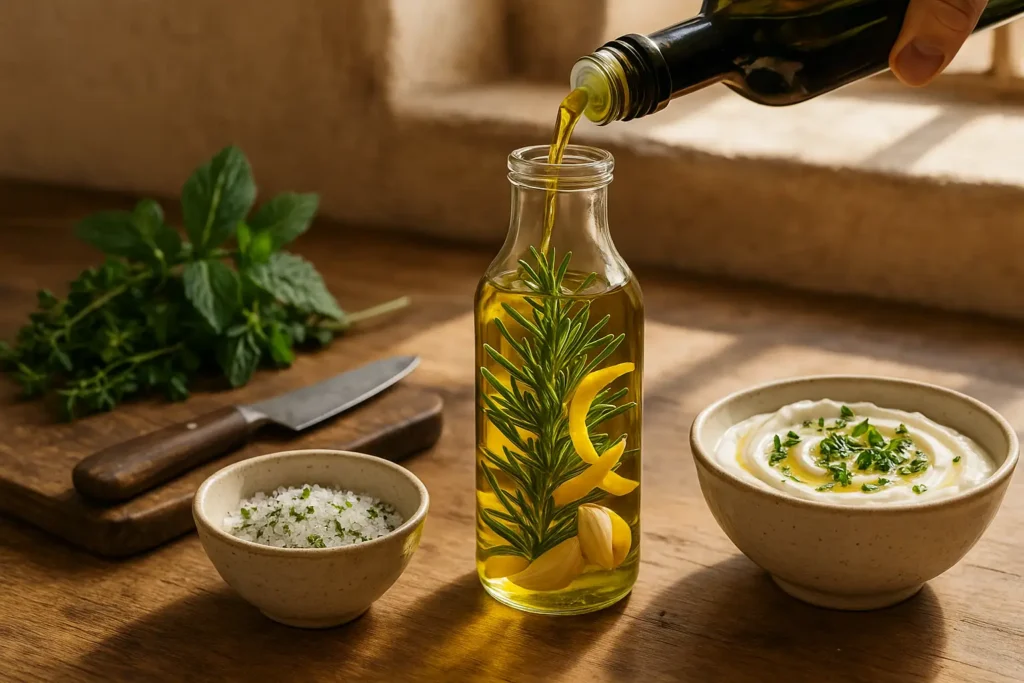
Homemade Herb Oils and Infused Vinegars
Preserving herbs in oil or vinegar allows their flavours to intensify over time. These infusions offer both convenience and boldness when you’re short on time but craving fresh flavour.
- Mint Vinegar: This cuts through heavy dishes such as lentil stews or roasted vegetables. It also sharpens grain salads beautifully.
- Herb-Infused Olive Oil: Drizzling rosemary or thyme oil on flatbreads or labneh brings added aroma and depth.
- Gift-worthy bottles: Layer herbs, garlic, and citrus zest into oils. This creates homemade mixtures that impress at any dinner party.
Seasoning Mixes with Dried and Fresh Herbs
Combining fresh and dried herbs opens up a range of textures and intensities. Classic spice mixes take on new life when fresh greens are added right before serving.
- Fresh Za’atar Additions: Mix in chopped oregano or marjoram at the table for an extra aromatic finish.
- Herb-Topped Cheese: Add finely chopped mint and thyme to soft cheeses like labneh to create an easy mezze dish.
- Custom Herb Salts: Mix coarse salt with finely chopped rosemary, mint, or lemon peel for seasoning meats or dips.
Fresh Herbs in Drinks and Smoothies
Herbs used in drinks can boost flavour while adding a natural cooling or cleansing effect. This works well in both traditional and modern recipes.
- Mint Lemonade: A refreshing classic that pairs beautifully with spicy dishes or outdoor meals.
- Parsley-Tahini Smoothie: A savoury combination that’s rich in iron and ideal for a late breakfast or lunch pairing.
- Herbal Teas: Use sage, lemon balm, or thyme for soaking in the evening to support digestion and relaxation.
Garnishes That Pack Flavour and Aroma
Thoughtful garnishes affect how a dish smells and feels in the mouth. A perfectly chosen herb garnish shows care and adds complexity without trouble.
- Mint or Cilantro Tufts: These offer a fresh pinch to warm dishes like kofta or charred eggplant.
- Lemon-Parsley Sprinkle: This combines brightness and crunch. It’s especially effective on rice, soups, or roasted vegetables.
- Final-Layer Marinades: Toss herbs with hot food just before serving. It’ll gently release their essential oils.
Styling Plates with Edible Greens
Herbs help dishes look as good as they taste. Their texture and structure also contribute to the experience of the food visually and aromatically.
- Flat-Leaf Parsley Sprig: This adds contrast and freshness to lentil dishes, grilled fish, or rice platters.
- Mint Leaf Halo: This outlines spreads like baba ghanoush or hummus with a natural, fragrant border.
- Functional Garnish: Choose herbs like dill or coriander. They release aroma with each bite for added pleasure.
Bringing Middle Eastern Flavours to Life
Fresh herbs define the character of Middle Eastern food. Their sharp aromas and vibrant colours bring depth and energy to every plate. If you use them thoughtfully, herbs like parsley, mint, and cilantro help express culture, care, and a love of honest cooking.
This article covered the origins of herb traditions, explored taste profiles, and shared practical tips on storing and handling herbs. We also looked at health benefits, as well as inventive ways to use herbs in drinks, oils, and food styling.
Find more on Zaytoon’s Food Blog. We have fresh recipes, kitchen tips, and real stories that honour Middle Eastern food traditions.
